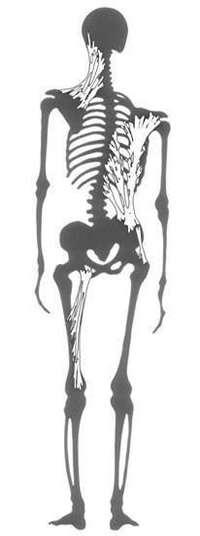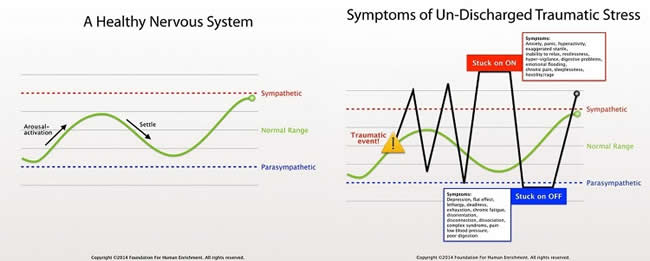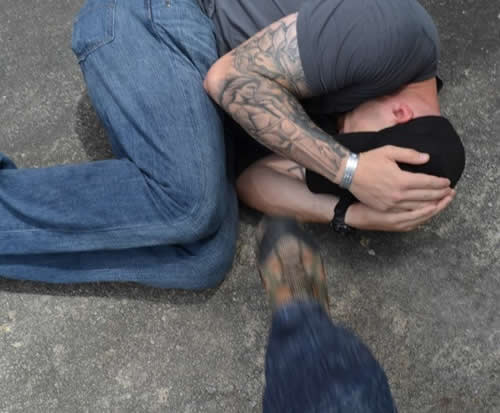Positive Health Online
Your Country

Physical and Emotional Holding as a Result of Injury, Stress and Trauma
listed in bodywork, originally published in issue 267 - January 2021
Our response to and therefore recovery from physical and emotional injury or trauma lies within our physiology. What I have witnessed in my 27 years as a bodywork therapist is that injury, stress, trauma and patterns of overwhelm manifests in the body, are held within the soft tissue, which then affect the fluid dynamics and therefore health. This is a natural, protective response. As Peter Levine says. “Until we understand that traumatic symptoms are physiological as well as psychological, we will be woefully inadequate in our attempts to heal them.”[1]
Physical Holding Patterns
Fascia a connective tissue, is physically injured in a multitude of ways, some of the more common ways our soft tissue is injured are mentioned below;
- Impact injury such as a fall, car crash, or impact sports such as rugby or American football;
- Lack of movement caused by either a sedentary lifestyle or immobilization;
- Repetitive movements or habitually poor posture also injure fascia;
- Scar tissue caused by surgery;
- Inflammation, whether caused by any inflammatory disease or as part of wound healing;
- Scalds and burns, including from treatments such as radiotherapy.
All of the above compromise the integrity of the inter-connected whole that is the fascial system. When the fascia is injured the body starts to compensate around the initial restriction creating further physical holding patterns. There is also an emotional component to all injury.
When fascial tissue becomes bound down, compensatory patterns begin to emerge. We compensate around the initial restriction, to ensure we continue to function at our optimal capacity, despite our injury or injures. We are all constantly making compensations to minimise the impact of injury, to continue to function to the best of our ability and to stay upright in space.

IMAGE 1: physical holding patterns, initiated through an injury
Take this simplified image of fascial restrictions as an example. Let us assume that the initial injury was on the right side of the body. A big impact has caused the fascial restrictions to the torso (multiple muscles and their associated fascia have contracted), the fascia has bound down in a protective response and structures are being pulled out of alignment – the right ilia has been drawn upwards towards the shoulder. So, the body starts to compensate, the left hamstrings and associated fascia begin to contract in an attempt to provide pelvic stability. The fibres on the left upper trapezius and associated fascia begin to contract – to prevent the body from being pulled further to the right – this is an attempt to minimise impact and keep the body upright in space.
There are no clear patterns to the manifestation of these compensations, which due to the connectivity of fascia can manifest and be palpated literally anywhere at and beyond the sight of the initial injury. We have all sustained a multitude of injuries from our embryological beginnings to the present day and compensations can take place in any direction. Skilful postural observation is a great tool which enables you to gain information on the manifestation of fascial restrictions. However, these restrictions can run deep into the body, down to a cellular level; the ability to ‘plug in’ to your client’s fascial system, to feel beyond your hands and to really connect with the three-dimensional fascial system is essential for truly effective work. The ability to feel beyond your hands into the viscera of the body, will take your attention to the holding patterns deep within the client’s system, an invaluable skill for effective bodywork.
Emotional Holding Patterns
Less documented, but equally or more important are the emotional holding patterns that manifest in our physiology, when working with clients whose recovery falters, I would suggest that there is a big emotional component to their injury or pain. As Peter Levine says: Without the body and mind accessed together as one unit we will not be able to deeply understand or heal trauma. Emotional holding patterns can manifest both systemically and locally - and often in fascial contraction - these are witnessed in each and every one of us. “Trauma is not what happens to us, but what happens inside, in the absence of an empathic witness.” [2]
SYSTEMIC holding patterns that I frequently witness in clinic are explored below.
- Freeze Response: The whole system may appear frozen and shut down; fascial tissue has contracted in a protective response. This immobility response is involuntary, it is not under conscious control, and it resides in primitive and instinctual parts of the brain and nervous system. By freezing we enter an altered, protected state in which no pain is experienced (like an animal in the wild about to be torn apart), this is a natural response that we should come out of when the threat of danger has passed. “In trauma the body tenses in readiness, braces in fear, freezes and collapses in terror. When the mind’s protective response to overwhelm returns to normal, the body’s’ response is also meant to normalize. When this restorative process is thwarted, the effects of trauma become fixated in the body and the person becomes traumatised.”[3]
Frequently in humans the restorative process is thwarted, and we remain in this frozen or semi frozen state long after the danger has passed. There is an outward appearance of immobility, lack of movement and the manifestation of trauma alters our body tissues, which stiffen and become dense in a protective response. This affects global and local mobility, the dense tissues can impinge nerves and other structures; causing pain, reducing fluid flow and motility. In some cases, the epidermis looks and feels waxy, the musculature and fascia of the entire body or part of the body may appear dense, bound down and lack healthy movement. In cases like these, setting up a sense of safety and ensuring your client is sufficiently resourced is fundamentally important before any hands-on work is applied. With technique start sensitively and progressing depending on palpation and tissue feedback. - Continuous Sympathetic Nervous System Activation is another indication of a systemic emotional holding pattern, when continuous sympathetic nervous system activation manifests throughout the body, this is frequently palpated as systemic vibration. The client may also be reporting other symptoms listed in the illustration below (anxiety, panic, hyperactivity etc). This physical manifestation of stress, trauma or anxiety is often referred to as being stuck on ‘on’, without the ability to go into rest and recovery. The body is trying to discharge Sympathetic activity from the system as vibration. Below you will see two illustrations one of A Heathy Nervous System, where we effortlessly move from parasympathetic to sympathetic activity and back again. The other an illustration of Symptoms of Un-Discharged Traumatic Stress, otherwise known as being stuck on ‘on’. For best clinical results, when witnessing this, I would recommend static hand contact (on top of towels); be truly present and grounded as a therapist and wait for the vibrational, activation from the Sympathetic Nervous System to settle completely before applying any further techniques. Simply allowing for systemic dropping down can bring huge relief, build trust and understanding between patient and practitioner.

- Foetal Position: moving into the foetal position is a manifestation of a global emotional protective response. If we were physically attacked, we would assume this position to protect our vital organs, however when deeply stressed or suffering anxiety the parts of our body which take us into the foetal position are often contracted and remain contracted. Even without gross movements, we frequently engage the muscles and associated fascia that would take us into the foetal position. Research shows that whether you are physically kicked or just hear something hurtful, the pain registers in the same brain areas - principally, the amygdala - and causes similar responses. This is why we may assume the foetal position, as if punched in the stomach when notified of something horrific. It can be useful just to sit and witness what happens to your body physiology when you recall a very difficult incident, or a truly emotional time. Witness what parts of your body seem to contract. Or the next time you need to slam on your bike or car breaks, witness what parts of your physiology contract. Do your hip flexors or pelvic floor engage, does your lower abdomen or respiratory diaphragm contract? Do your shoulders hunch forward and inward in protection? Does your head drop to protect your throat? What else do you witness? These areas of contraction will give you an abundance of clues as to where you will find fascial contraction on your clients and where to treat in clients who are experiencing stress and anxiety.

The viscera is a rich storage jar of emotional holding, I will explore this in detail in my next article.
By addressing the physiology we can begin to change habitual physical and emotional holding patterns, and with skilful application of fascial techniques, bound down tissues soften and re integrate into the fascial web, realignment and expansion can take place, fluid flow can now increase as restrictions resolve. Involuntary movements may take place as activation from the Sympathetic Nervous system is discharged. Cold can sometimes be felt by practitioner and patients alike as shock leaves the system. Heat from a thwarted inflammatory response can often be felt as resolution takes place. As the physical changes takes place so the emotional holding pattern is integrated and processed.
References
1. Peter Levine; ‘Wounds That Can Heal’, Waking the Tiger Healing Trauma; North Atlantic Books; P.32. 1997.
2. Dr Peter Levine; In An Unspoken Voice; North Atlantic Books;
3. Dr Peter Levine; ‘Giving the Body its Due’, Waking the Tiger Healing Trauma; North Atlantic Books; P.5. 1997.
Note from Emma
Emma Gilmore: Director School of Bodywork, international bodywork teacher, judge of National Massage Championships. I look forward to exploring more about emotional holding patterns in the viscera in my next article of PH Online. info@schoolofbodywork.com www.schoolofbodywork.com
Comments:
-
No Article Comments available